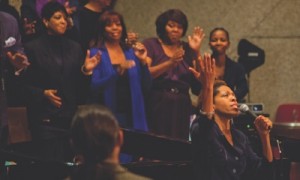My interest in worship has emerged from our studies of the relationship between church attendance and health-related outcomes. One of the major questions that informed our earlier studies of worship included the following: “What changes occur in parishioners on a spiritual, emotional, cognitive, and physiological level in response to worship?” Another major question was, “What is it about the rhythm, the lyrics, the melody, the presentation, the singers, the listeners, and their relationship to God that ushers in God’s presence through song?”
 A new question has emerged for me, my students, and colleagues. During praise and worship in corporate services, there are moments that parishioners experience as powerful, anointed, and convicting. Does the worship leader’s spiritual, emotional, cognitive, and bodily engagement influence parishioners’ spiritual experience in these moments? My theology colleagues are helping me explore additional questions concerning God’s incarnational work in creativity, the role of the Holy Spirit in worship, and the role of revelation in embodiment.
A new question has emerged for me, my students, and colleagues. During praise and worship in corporate services, there are moments that parishioners experience as powerful, anointed, and convicting. Does the worship leader’s spiritual, emotional, cognitive, and bodily engagement influence parishioners’ spiritual experience in these moments? My theology colleagues are helping me explore additional questions concerning God’s incarnational work in creativity, the role of the Holy Spirit in worship, and the role of revelation in embodiment.
One approach to understanding this engagement is to examine the role of embodiment. Gibbs (2005) notes that music perception is associated with embodied movements (e.g., breathing, rhythmic gaits). Shove and Repp (1995) state, “the listener does not merely hear the sound of a galloping horse or bowing violinist; rather, the listener hears a horse galloping and a violinist bowing” (p. 59). Consequently, “musical perception involves an understanding of bodily motion—that is, a kind of empathetic embodied cognition” (Gibbs 2005, p. 53; Iyer, 2002). Dunn and Jones argue that vocal meaning arises from “an intersubjective acoustic space” and any effort to articulate its meaning must include a reconstruction of this context. Therefore, understanding musical expression in worship includes understanding the producers of the sound, the listeners, and the social context. For worship song leadership, this includes the worship song leader and the process of preparation as well as the social and spiritual context of song production.
We are conducting a preliminary study [at time of publication] that seeks to understand from worship leaders those factors that contribute to their spiritual engagement in leading worship and greater attunement by congregations. The focus of this preliminary phase is identifying key dimensions that facilitate and impede full embodiment—an integrated spiritual, emotional, cognitive, and physical embodiment. Of interest are the ways that worship leaders have been trained and how they have trained others to reflect this engagement.
REFERENCES
Dunn, L., & Jones, N. (1994). Embodied Voices: Representing Female Vocality in Western Culture. Cambridge: Cambridge University Press.
Gibbs, R. W., Jr. (2005). Embodiment and Cognitive Science. New York: Cambridge University Press.
Shove, P., & Repp, B. (1995). “Musical Motion and Performance: Theoretical and Empirical Perspectives” in J. Rink (ed.), The Practice of Performance (p. 55–83). Cambridge: Cambridge University Press.
This article was published in Theology, News & Notes, Spring 2012, “Groanings Too Deep for Words: Engaging the Senses in Worship, Theology, and the Arts.”

